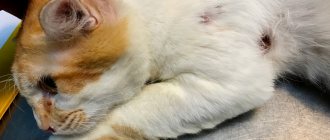The appearance of subcutaneous lumps on the body of a pet is an alarming sign that requires mandatory diagnosis. The wide variety of possible causes precludes any attempt at self-treatment. An incorrectly selected technique can harm the pet and worsen its well-being.
Despite the danger of possible consequences, do not panic. Many neoplasms are benign. For an accurate result, a thorough examination at a veterinary clinic will be required.
Types of subcutaneous formations and their symptoms
First of all, the doctor will determine the nature of the tumor. Further treatment will depend on it.
Benign
If a benign neoplasm occurs, the cat does not lose activity or appetite. The ball that appears is not accompanied by pain, is soft to the touch and is separated from healthy tissue. Such formations include:
- Syringoepithelioma
. The lump appears on the stomach, does not change size and is not accompanied by pain. The skin glands that regulate sweat secretion are responsible for its occurrence.
- Lipoma
. A simpler and more familiar name is wen. It appears at the site of fat reserves, has the shape of a circle or oval and rolls freely when palpated. The wen does not metastasize, but often increases in size. Surgical removal is allowed if there is a stable increase or persistent itching that bothers the cat.
- Hemangioma
. In 90% of cases, hemangioma is congenital. It is formed from blood vessels in the subcutaneous tissue. Swellings appear on the sides, abdomen or back of the body. If the hemangioma is acquired, then the reason for its appearance lies in ultraviolet radiation. It is typical for pets living in hot climates with free access to outdoor exercise.
- Adenoma
. The cause of adenoma development is hormonal imbalance. Nodular growths resembling cauliflower appear on the eyes, head and milk bags. In the latter case, there is a high probability of developing into a malignant form.
The danger of lipoma increases depending on where it appears. When located on the paws, it causes lameness, and when it occurs on the carotid artery, it threatens sudden suffocation due to the pressure exerted.
A purple ball on a cat’s skin, accompanied by pain when pressed, is a hematoma, that is, a bruise. Despite the presence of pain, it also refers to benign neoplasms. Sometimes a hematoma develops into a cyst, so monitoring its changes is recommended for prevention purposes.
Malignant
The first alarming symptom is an increase in temperature at the site of the lump: on the neck, head, withers or mucous membrane of the throat. If the ball enlarges and the animal experiences acute illness (diarrhea, vomiting, increased general temperature), contact your veterinarian immediately. Malignant neoplasms are dense to the touch. As they grow, the affected area becomes covered with ulcers, festers and gradually dies. Malignant tumors include:
- Swelling due to mastitis
. Small bumps appear on your pet's nipples. As they grow, the affected mammary gland increases in size, turns red and becomes hot to the touch. Gradually, foreign flakes and pus impurities enter breast milk. If the cat is nursing, she must be temporarily separated from the kittens. A sick animal becomes lethargic, loses appetite, suffers from nausea and intestinal upset.
- Mammary cancer
. If doctors suspect oncology, then in 80% of cases breast cancer is confirmed. A nodular tumor forms in the vicinity of the milk bags and the groin area. The rapid appearance of new balls in a cat on the neck and under the skin in the paw area indicates metastasis of the pathology throughout the body. The bumps turn red or purple and move freely under the skin. At an early stage, the disease is asymptomatic, preventing timely diagnosis. The occurrence of bleeding and purulent discharge indicates the last stage of cancer, which can be fatal.
- Abscess
. A painful lump filled with foul-smelling dirty-brown pus is accompanied by an increase in general temperature and local hair loss up to complete baldness of the affected area. If left untreated, the ball ruptures and infects the blood. If such a formation appears on the eye, then there is a high probability of vision loss.
In any case, there is no need to panic - it is better to throw all your efforts into saving or alleviating the fate of a sick pet. It is known that love and care can work miracles even in the most hopeless cases.
Others
In addition to the listed neoplasms, five more are distinguished. They can be both benign and malignant and can flow from one form to another. These include:
- Cyst
. Round balls with watery contents have clear boundaries. They do not hurt, they are rarely malignant, but they can bother the cat due to their large size.
- Hernia
. The size of the formations ranges from a small pea to a chicken egg. They appear near the navel or groin area and are internal organs that have prolapsed from the peritoneum under the skin. If the prolapsed organ is pinched, it lacks blood and begins to die.
- Inflammation of the paraanal glands
. The appearance of subcutaneous balls clogs the excretory tract. Inflamed glands that stimulate the process of defecation cannot perform a secretory function. The formations resemble a hernia, but are able to change their size when the pet’s position changes. If it is positioned vertically with its head up, then the balls increase in size. If his head looks vertically down, then the situation is the opposite.
- Eosinophilic granuloma
. A dense red skin formation gradually grows into neighboring tissues. An open, moist wound is formed, attracting harmful microorganisms.
- Lymphadenitis
. The cause of the disease is an inflamed lymph node. It is immobile and causes severe pain even with slight swelling. The knot has a dense structure and oblong shape.
The type of neoplasm can be determined solely by its location in only two areas: under the tail near the anus and on the stomach in the area of the milk bags. In the first case, the animal’s paraanal glands are inflamed, and in the second, we are talking about mastitis or oncology. All other cases are diagnosed exclusively by a veterinarian.
Mastopathy in cats
Mastopathy in cats
It is a benign formation in the mammary glands of cats. As the formations progress, they can degenerate into oncology. The disease leads to a deterioration in the pet’s well-being. It responds well to treatment in the initial stage.
Causes
Most often, the cause of the pathology is a hormonal imbalance. The trigger can be pregnancy, including false pregnancy, various gynecological diseases, mammary gland injuries, abortion in cats.
Forms of the disease
There are several types of the disease.
- In the diffuse form, small nodules of connective tissue are formed;
- The nodular form is manifested by the appearance of foci of compaction;
- In the mixed form, cysts and a process in the form of fibrosis are formed.
In addition, there are several stages of the disease. Depending on the characteristics of the course.
Symptoms
The first signs of the disease very often go unnoticed. However, you may notice changes in the animal's behavior. It loses its appetite, becomes lethargic, constantly licks its nipples, and aggression may appear for no apparent reason.
As the disease progresses, nodules begin to form in the cavity of the mammary glands, and the mammary glands themselves become painful. Gradually, the process invades the lymph nodes; discharge may appear in the form of a cheesy mass, in which blood and pus are present. The animal refuses to feed the kittens and meows.
Diagnosis of pathology
If you suspect, you should show your pet to a specialist. The diagnosis is made by examination by palpation. In addition, tests and a number of examinations, for example, ultrasound, are prescribed. To clarify the nature of the formations, a biopsy is performed.
Treatment and prevention
At the initial stage, treatment is carried out at home. If this is a recently lambed cat, then it is transferred to dry food and the amount of water is reduced. Kittens are transferred to artificial feeding. The doctor prescribes drug therapy and necessary manipulations. Severe forms are treated surgically. The danger of the disease is that in an advanced stage it develops into oncology.
The method of prevention is regular examination of the animal, protecting it from injury, as well as timely treatment of concomitant diseases.
Causes of subcutaneous lumps
Small round balls often appear after injection under the skin. They are called post-injection granuloma and resolve on their own a few days after the end of the injections. To avoid them, the injection site is massaged daily. Sometimes granulomas remain for life, without changing their size and position. In other cases, the reason lies in:
- blockage of the sebaceous glands;
- allergic reaction;
- infestation with parasites;
- hormonal imbalances;
- infection of open wounds;
- disturbances in the formation or functioning of connective tissues;
- injuries;
- inflammatory processes.
The risk group includes older animals, cats with chronic diseases, late castrated and sterilized pets. The risk of developing cancer increases with constant stress, low activity and poor diet. A predisposition also appears with frequent injuries in the same area of the body, infection with leukemia and regular inhalation of tobacco smoke. Cancer is often inherited and is diagnosed in animals older than 7 years.
A tumor on a cat's stomach can be of different types.
So, the formation of a tumor on a cat’s abdomen is a common occurrence. It can be benign or malignant in nature. Depending on what tissue turned out to be the “building material,” malignant tumors come in different types.
In males, a fairly rare type of cancer occurs - intraepithelial. Cancer in females also varies. It could be carcinoma. It is formed from epithelial tissue. Another type is adenocarcinoma. Its “building material” is glandular tissue.
Precautionary measures
If the lump under the skin turns out to be a tick, contact your veterinarian immediately. The most dangerous parasites carry encephalitis, so if treated independently, not only the cat, but also the owner may suffer. First aid is recommended only when an urgent visit to a veterinary clinic is not possible. To do this, strictly follow the instructions for removing ticks. If you don’t know her, contact your doctor by phone. Improper removal may result in blood poisoning.
Never squeeze out cones with purulent contents. Damage to such seals leads to infection of deeper layers of cellular tissue and a severe form of abscess.
In the later stages of cancer, the likelihood of saving the animal is minimized. If you want to protect your sick pet, sign up for a veterinary clinic for diagnosis immediately after detecting subcutaneous lumps.
How to prevent stomach tumors in cats
Unfortunately, there is no way to prevent the development of tumors. However, it is possible to keep your pet healthy for as long as possible. To do this, you need to organize the right diet for her. It does not include leftover food from the owners. The animal should be fed only with specialized food.
You can add vegetables and fruits to your diet; they are seasoned with vegetable oil. Food is selected depending on the age category, as well as taking into account the state of health. It is very important to prevent the occurrence of stressful situations for the animal.
Diagnosis and treatment of neoplasms
Diagnosis is carried out when any neoplasm appears. After a thorough examination, the doctor determines the level of danger of the resulting compaction and selects the appropriate therapy.
In addition to a clinical examination and history taking, it is necessary to check the functionality of the heart, study a general analysis of urine and blood, and also do a bacteriological analysis of the contents of the lump-vesicle. Using ultrasound and x-rays, the doctor determines the depth, exact location and size of the tumor. At an early stage, cancer is often asymptomatic, so biopsy and endoscopy are used to detect it.
The location of oncology development directly depends on the sex of the animal. Cancer in cats most often affects the testes, and in cats - milk bags. If the disease is detected at an early stage, therapy is reduced to taking special medications and gives positive results. At later stages the prognosis is negative. The patient is given painkillers and euthanized.
Table of primary and additional therapy
Drug or surgical therapy depends on the diagnosis, the state of immunity and the stage of development of the disease. Recommended treatment methods can be found in the example table.
| Type of pathology | Therapy | |
| Main | Additional | |
| Lipoma | Surgical excision of large lumps | Lipomas located near the spinal column or neck are not recommended to be touched. Intervention is allowed only if the lipoma is growing steadily |
| Hemangioma | Non-interference and surveillance | Complete surgical removal on an individual basis |
| Adenoma | Subcutaneous and intramuscular injections of antibiotics, antiviral and antifungal drugs | Surgery for increasing size |
| Mastitis | The animal is given a novocaine blockade, physiotherapy, a course of antibiotics and compresses are prescribed. | In advanced forms, surgical intervention is used |
| Cancer | In addition to special medications, the doctor prescribes radiation or chemotherapy followed by removal of the tumor | In later stages, pain management is used and euthanasia is recommended. |
| Abscess | An autopsy is performed and pus is removed using antiseptics. The treated area is isolated with a sterile bandage. Any remaining infection is treated with a course of antibiotics. | Long-term use of antibiotics is dangerous for the developing organism of kittens. If the animal is less than 1 year old, the veterinarian tries to reduce the recommended duration of antibiotic therapy as much as possible. |
| Cyst | For small formations, observation is recommended; for large ones, removal | Sometimes parasites are found in the growths. In this case, surgery is necessary even for a small cyst |
| Hernia | To remove a hernial lump, massage sessions are prescribed, the prolapsed organ is put back in place | For large formations, the doctor performs surgery to stitch the diverging ring |
| Inflammation of the paraanal glands | The accumulated fluid is squeezed out, facilitating the production of secretions | If pain occurs, the animal is injected with novocaine. If a predisposition to inflammation is identified, the cat will have to be taken for the procedure several times a year. |
| Eosinophilic granuloma | Based on the cause of the pathology, the cat is prescribed antibiotics, antihistamines or steroids. | A large weeping wound is usually excised to preserve the appearance of the affected area |
| Lymphadenitis | The disease is not independent and occurs against the background of another pathology. Painkillers, anti-inflammatory and antibacterial drugs are used for treatment | A large number of inflamed lymph nodes indicates leukemia. This pathology is not fatal, but requires long-term drug treatment |
Syringoepithelioma is not considered dangerous to health, so treatment is not provided. Hematomas resulting from minor injuries usually go away on their own or are eliminated with healing ointments.
In addition to traditional scalpel work, surgeons use laser excision, electric shock, or freezing at low temperatures with liquid nitrogen. Young and healthy animals with strong immunity often heal on their own. In this case, they receive immunity, eliminating subsequent relapses.
After surgery, the animal is prescribed a course of immunomodulators that stimulate the functioning of immune cells. The remaining wound is treated with healing ointments. Bandages can be changed yourself or at a veterinary clinic. Be sure to consult a doctor if pus continues to leak from the bandage after surgery. Some tumors found in cats are dangerous not only for animals, but also for humans.
What to do with purulent and bleeding seals?
The appearance of bleeding and purulent discharge is a symptom of cancer. Immediately upon discovering a problem, take your pet to see a veterinarian.
Before visiting a doctor, it is prohibited to treat wounds with alcohol-containing solutions, squeeze out or puncture the lump. It is also not allowed to use any ointments without prior consultation. Even plain water can make the situation worse, so do not try to rinse or wet the swelling.
If the seal breaks on its own, provide first aid to the animal. To do this, you need to treat the wound with an alcohol-free antiseptic and apply a sterile bandage. All these actions do not exclude a veterinary examination.
Symptoms
During an oncological process in the body, the animal is often irritated.
If the bump on the head of a cat or kitten is benign, then it is soft to the touch, rolls under the skin, and does not hurt or bother you when pressed. Internal malignant growths often appear as capsules that can be normal temperature or hot. A lump on the withers, on the side of the neck or on the mucous membrane in the throat from degenerated cells quickly increases in size. In addition, an adult cat or kitten develops the following symptoms:
- weakness;
- irritability or lethargy;
- digestive problems;
- refusal to eat;
- sudden weight loss;
- dyspepsia.











